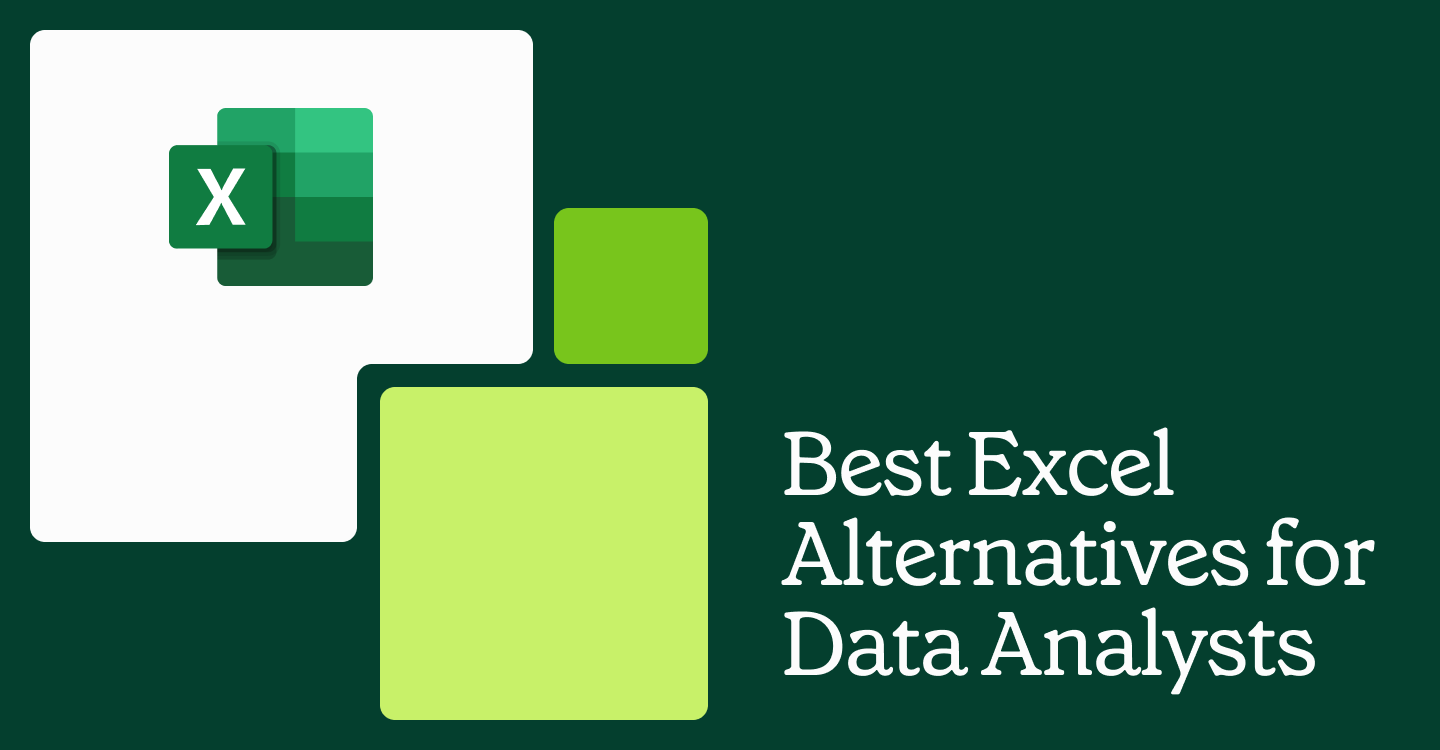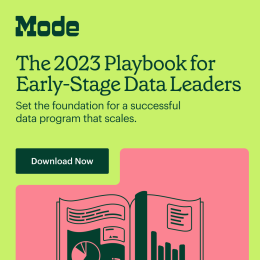Best Excel Alternatives for Data Analysts
Laura Dambrosio, Mode team writer
January 10, 2023
NaN minute read

Best Excel Alternatives for Data Analysts
Excel has always been a go-to for analysts who need a basic, reliable data analysis tool. With well-known formulas, pivot tables, and simple charts, an Excel spreadsheet mostly did the job—until it didn’t. Today analysts need solutions for the big data era, with features that allow for deep exploration of data, enable collaboration, and make it easy for anyone to visualize large and complex datasets.
If you’re looking to move on from the limitations of Excel, this article will help you navigate the crowded market of data analytics tools, find the right feature set for your needs, and learn more about adopting a modern business intelligence solution. Read on for a look at the top Excel alternatives for data analysts and their stakeholders.
What to keep: Excel’s top features
Most analysts still using Excel for their primary data analysis workflows are doing so for the simplicity and familiarity. While the spreadsheet program doesn’t support advanced analysis or the intuitive, user-friendly dashboards of its more modern counterparts, it does have a few points in its favor:
Excel is a simple, no-frills tool that a single analyst can customize to their own workflows.
Every analyst understands how to use Excel, and if they don’t, the learning curve is shallow for the most common use cases.
Pretty much every enterprise application allows CSV imports and exports from Excel.
Analysts can emulate more advanced software by creating homegrown solutions in Excel, as long as the use case isn’t too complex.
What to rethink: Excel’s biggest limitations
When comparing Excel to other spreadsheet programs like Google Sheets, Zoho Sheet, or Apache OpenOffice’s Calc, the differences are fairly minor. But putting it up against today’s best solutions for advanced data analysis shows that it’s limitations are pretty prohibitive:
Excel can’t handle large datasets or combine different data types and formats.
Excel doesn’t allow for real-time analytics, machine learning, or any cutting-edge analysis.
It’s hard to track changes and comments in Excel’s user interface
Analysts can’t build in guardrails that keep data clean and standardized.
Excel workflows aren’t secure enough for the modern tech stack.
As an everyday tool for project management, quick calculations, and consumer use cases., Excel remains an option nearly anyone can use. However, as an analysis tool for data-driven companies, Excel is almost entirely obsolete.
Is Excel still used for data analysis?
The short answer is kind of. It’s found in slower-moving industries or on small, siloed teams of analysts. However, for companies that employ data teams dedicated to understanding how their business operates, what drives performance, and how to answer questions that help each team reach their KPIs, Excel is more of a supplemental workaround or fallback tool that’s used alongside a business intelligence platform, R & Python notebooks, and ETL solutions.
Excel vs Google Sheets
Google Sheets is one of the closest Excel alternatives that you’ll find on the market, as a spreadsheet-based tool for storing, visualizing, and presenting data. Google Sheets enables collaboration and sharing and has compatibility with Microsoft Excel files including many keyboard shortcuts.
Google Sheets has almost all the same features that Excel offers. Sheets is also highly collaborative and supports real-time data sharing. However, Sheets is very resource-intensive. Like most Google products, it consumes a significant amount of RAM. To address this, you can take steps to reduce RAM usage, such as closing unnecessary browser tabs, limiting the use of add-ons, or simplifying complex formulas. It also comes with fewer formatting options than Excel.
Excel vs SQL
A good entry-level Excel alternative is to get data into a database and start using SQL to run queries instead. It’s not hard to learn how to switch from Excel to SQL, as the language is fairly simple and was built to query relational databases (the same data structure Excel was built for).
Taking this step opens up a whole new category of mid- and enterprise-grade data solutions. Analysts can use SQL to query much larger datasets, write and save complex queries, and create visualizations that make reporting much more customizable.
Excel vs Python
Excel power users (and their counterparts in Google Sheets, OpenOffice, et al) know the program’s syntax inside and out. But to really master Excel, users have to learn Visual Basic or VBA, the language used to write macros and do more advanced work—even if they do, it’s a far cry from what even Python basics can do.
Python is a programming language that lets analysts automate data workflows at scale, transform and normalize it across applications, and eliminate much of the tedious work associated with manually managing data in spreadsheets. It’s extremely useful for connecting different systems and formats. It’s also a well-accepted part of the modern analyst toolset, with a thriving community of contributors and a use case far beyond what Excel was made for (including machine learning, data mining, and developing entire applications and backend operations). Case in point: here are 12 Python data visualization libraries that will blow your Excel charts out of the water.
Because of its ubiquitous nature and flexibility, analysts who use Python often do so in shared Python notebooks and reporting solutions where their teammates can examine their analysis and collaborate on data projects.
Excel vs R
R, a language and environment for data analysis, is similar to Python in that it’s used to clean, model, visualize, and manage data at scale. It has a more narrow use case—R isn’t used to build whole applications like Python is—but is a gold standard for statistical analysis and a powerful tool for experimenting with regression models, neural networks, and other advanced machine learning techniques.
Together, Python and R cover everything an analyst might do in Excel and more.
Excel vs business intelligence (BI)
BI tools are a good replacement for Excel users who don’t want to program or build complex models, but do want to track business KPIs across many departments and systems. BI solutions replace the need to collect data from each team or solution, combine it and normalize it using manual Excel workflows, and then import it back or paste charts into reports for stakeholders.
Modern business intelligence solutions do something Excel wasn’t built for. They allow data teams to integrate across all of their data sources and solutions, then present data to stakeholders in real-time, customizable reports and dashboards. These BI platforms are built for today’s massive datasets and enterprise workflows, so they include tools for piping data from solutions like Salesforce, Zendesk, Slack, Jira—the options are endless—and transforming it with a number of ETL solutions.
Once data is in a single warehouse, BI platforms like Mode can be used to dive deep into analysis, share data throughout the org, and build self-serve products for non-analysts to find answers without creating a backlog for the data team.
While some analysts might get by on Excel vs R or Python, there’s simply no way to connect business data and learn from it without leaving spreadsheets behind for good.
Read now

Best practices for automating reports in Mode
Data teams save time when they automate reports.
The best Excel alternatives for advanced data analysis
Mode
Mode is a modern business intelligence platform that enables teams to quickly discover insights and answer questions using raw or modeled data. The platform increases self-service analysis and data maturity and helps teams unlock value from the data stack.
Mode pros and cons
Mode has a high-technical ceiling that gives data teams acrobatic abilities when it comes to advanced analysis, while enabling business teams to use trusted data, curated by data experts. This experience creates best-in-class decision support for answering complex questions. With Mode, you can drill down into complex data, create both advanced and custom visualizations, and deliver it in the manner of your choice.
Mode is easy to learn and comes with great customer support if you run into any issues. Mode also offers a free, comprehensive SQL tutorial to take users through basic, intermediate, and advanced SQL functions.
Mode top features
Mode is very easy to deploy. Unlike other BI platforms, you can be up and running on Mode within minutes. Ninety percent of users choose Mode over competitors for ease of setup.
Teams gain access to a central hub for finding useful, governed, and easy-to-interpret data. This lets companies turn organizational knowledge into a competitive advantage.
Mode empowers everyone to find their own answers with data teams curating data business teams can trust that inspires confident self-serve reporting.
Mode top benefits
Improve data literacy across the organization as collaborative data analysis empowers all users to explore data.
Gain rapid insights into complex business challenges through ad hoc analysis. Add query writers across the organization.
Build interactive dashboards, reports, and custom internal tools in a matter of hours or days.
Unlike legacy BI tools, Mode offers a single platform that can scale with your team, and decreases cycle time between data teams and business teams as your company scales.
Tableau
Tableau is a BI tool with a data visualization focus. Companies use Tableau to discover simple business insights and present and share them with other stakeholders.
Tableau pros and cons
Tableau is known for its data visualization capabilities. It’s also easy for business users to navigate the platform. Yet while Tableau empowers business users with simple tools, it misses the mark for data analysis by ignoring data teams’ most pressing needs. Instead of a reliable, dedicated support team, users have to rely on the community. See how Tableau compares to Mode.
Looker
Looker—which Google acquired in 2020—offers a self-service BI tool that helps customers gain insights about their business and customers from a central location. With Looker, you can create dashboards and reports that tell data stories, but can slow teams down with their modeling layer. One feature that Looker has is SQL Runner, which enables analysts to explore data and export reports to non-technical teams.
Looker customer feedback
Looker comes with a powerful tool for creating data models. You can connect Looker to an SQL database and automatically generate LookML models.
This platform is good for producing short reports and visualizations.
It’s not the best platform for visualization. For example, you can’t label or modify visualizations in Looker.
Metabase
Metabase is a free open-source project for sharing and working with business data. Its main uses include enabling self-service analytics, creating interactive dashboards, and embedding analytics into products.
Metabase pros and cons
Metabase is easy to set up and operate in just a few clicks. It also has a user-friendly interface for building and running queries. However, Metabase tends to lag with large datasets, making it a poor fit for teams analyzing data at scale. It’s also difficult for users who don’t have SQL skills to create custom dashboards.
Also, read the top Metabase alternatives that you should consider here.
Microsoft PowerBI
Microsoft PowerBI is a leading data visualization tool that connects to multiple data sources for business insights. This tool is for companies that have deep immersion in the Microsoft product suite and use tools like Excel for data management.
With PowerBI, you can create and modify data reports and dashboards and securely share them across different services. It also comes with a free training module that contains online learning resources and tutorials.
Microsoft PowerBI feedback
PowerBI has a useful mobile layouts view, which lets you create reports specifically for mobile devices — perfect for on-the-go employees.
Within PowerBI, you can upload data, slice it, and visualize it. The platform is intuitive compared to other tools on the market.
The free version of PowerBI comes with limited features and doesn’t unlock the full performance capability of the software. So, if you’re serious about data analytics, it’s worth paying for it.
The bottom line: Leave Excel behind for a purpose-built platform
No matter how familiar and comfy Excel feels, it’s just not a match for what data teams must accomplish to stay competitive today. If you’re not ready to commit a large budget toward modernizing your data stack, not to worry. You can sign up for Mode for free and start writing SQL, exploring Python and R notebooks, and integrating your data sources right away. Mode offers competitive, tiered plans so businesses at any stage can reap the benefits of their data.
Mode gives analysts much more than an alternative to Excel. Our platform makes it possible to move along the data maturity curve and make reliable, useful data analysis accessible to the whole company. With the help of Mode, your company can unlock the full value of your data.
To learn about how Mode can help your teams see clearer data, request a demo today.

The 2023 Playbook for Early-Stage Data Leaders
Create a data program that scales.

Watch a product tour of Mode
Curious about how Mode works? Sit back and watch the video—no reps ;)
Get our weekly data newsletter
Work-related distractions for data enthusiasts.




